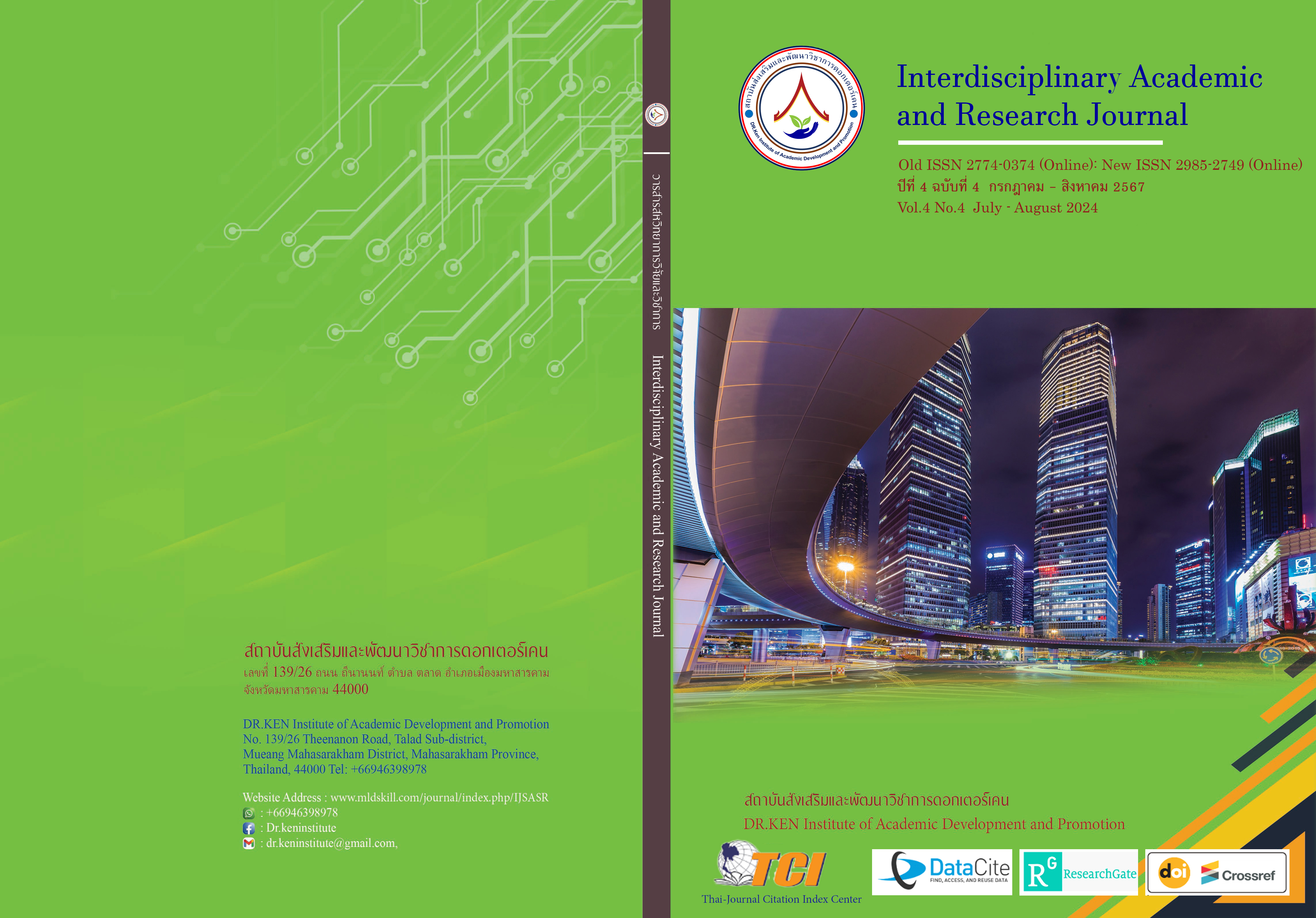Organizing Situational Storytelling Activities to Promote Problem-Solving Abilities of Early Young Children
DOI:
https://doi.org/10.60027/iarj.2024.277355Keywords:
Storytelling Activity; , Problem Solving Ability; , Early ChildhoodAbstract
Background and Aims: Engaging children in imaginative storytelling activities is crucial for enhancing their problem-solving skills. It allows them to think critically and make decisions while overcoming obstacles. Children gain emotional intelligence through storytelling as well because it helps them to understand different points of view and develop empathy for characters. By incorporating problem-solving components into these exercises, educators can establish dynamic learning environments that will serve as a solid basis for children's future cognitive abilities. Thus, this research aimed to compare young children's problem-solving abilities before and after organizing situational story activities and the problem-solving abilities of early childhood children after organizing situational story activities.
Methodology: The target group used in this research is early childhood children aged 5 - 6 years, Maha Sarakham Rajabhat University Demonstration School, Mueang District, Maha Sarakham Province. Under the Office of the Higher Education Commission, for the academic year 2023, 18 people were obtained from purposive selection. The tools used in this research include a situation storytelling activity plan and an assessment of early childhood children's problem-solving abilities in 3 areas: problem identification In terms of creating options and problem-solving Using a Pre-Experimental Design, the statistics used to analyze the data were the average. standard deviation and percentage of progress
Results: The research results found that The average problem-solving ability of early childhood children after organizing the Situation Storytelling activity had a value = 28.44, a value = 1.82, higher than before organizing the Situation Storytelling activity, which had a value = 19.50, a value = 4.97, with a percentage of progress equal to 42.73.
Conclusion: Putting together situational storytelling exercises improves early childhood problem-solving skills by an average of 42.73%. This indicates how well these kinds of activities foster cognitive development and get kids ready for new challenges down the road.
References
กระทรวงศึกษาธิการ. (2560). แผนพัฒนาการศึกษาของกระทรวงศึกษาธิการ ฉบับที่ 12 (พ.ศ.2560 – 2564). กรุงเทพฯ: กระทรวงศึกษาธิการ.
กุลยา ตันติผลาชีวะ. (2541). การเล่านิทาน, การศึกษาปฐมวัย, 2(2), 12 - 14.
จินตนา ปรีดานันต์. (2546). คำถามพัฒนาสมอง. กรุงเทพฯ: ธรรมรักษ์.
ฉันทนา ภาคบงกช. (2528), เขียนให้เด็กคิดโมเดลการพัฒนาทักษะการคิดเพื่อคุณภาพชีวิตและสังคม, กรุงเทพฯ: คณะศึกษาศาสตร์ มหาวิทยาลัยศรีนครินทรวิโรฒ ประสานมิตร
ชาญชัย ยมดิษฐ์. (2548). เทคนิคและวิธีการสอนร่วมสมัย. กรุงเทพฯ: หลักพิมพ์.
ดวงเดือน แจ้งสว่าง. (2542). นิทานสำหรับเด็กปฐมวัย. สงขลา: คณะครุศาสตร์สถาบันราชภัฏสงขลา.
ดวงพร ผกามาศ. (2554). ความสามารถในการแก้ปัญหาของเด็กปฐมวัย ที่ได้รับการจัดกิจกรรมประกอบอาหารประเภทขนมไทย ปริญญานิพนธ์การศึกษามหาบัณฑิต : มหาวิทยาลันศรีนครินทรวิโรฒ
ทิศนา แขมมณี. (2557). ศาสตร์การสอน : องค์ความรู้เพื่อการจัดกระบวนการเรียนรู้ที่มีประสิทธิภาพ. พิมพ์ครั้งที่ 18. กรุงเทพฯ:ด่านสุทธาการพิมพ์.
ทิศนา แขมมณี. (2562). ศาสตร์การสอน : องค์ความรู้เพื่อการจัดกระบวนการเรียนรู้ที่มีประสิทธิภาพ. พิมพ์ครั้งที่ 23. กรุงเทพฯ:ด่านสุทธาการพิมพ์.
ธีรภรณ ภักดี.(2550). ผลของการจัดกิจกรรมเสริมประสบการณ์เรื่องน้ำ ตามโครงการพระราชดําริที่มีต่อการแก้ปัญหาของเด็กปฐมวัย. ปริญญานิพนธ กศ.ม. (การศึกษาปฐมวัย). บัณฑิตวิทยาลัยมหาวิทยาลัยศรีนครินทรวิโรฒ, เทคโนโลยีราชมงคลธัญญบุรี
นภเนตร ธรรมบวร. (2544). การพัฒนากระบวนการคิดในเด็กปฐมวัย. กรุงเทพฯ : จุฬาลงกรณ มหาวิทยาลัย.
นภาปย สิริกรกาญจนา (2558). ผลของการจัดกิจกรรมนิทานคํากลอนที่มีต่อความสามารถในการแก้ปัญหาของเด็กปฐมวัย. ปริญญานิพนธ์การศึกษามหาบัณฑิต : มหาวิทยาลันศรีนครินทรวิโรฒ
บุญทัน อยู่ชมบุญ (2533). หลักการสอน, เชียงราย : คณะครุศาสตร์ วิทยาลัยครูเชียงราย
ประสาท อิศรปรีดา. (2538). การพัฒนาความคิดสร้างสรรค์ด้วยกระบวนการฝึก. มหาสารคาม:มหาวิทยาลัยมหาสารคาม.
พรรณทิพา มีสาวงษ์. (2554). ผลของการจัดกิจกรรมการเล่านิทานประกอบการใช้คำถามที่มีผลต่อทักษะการคิดวิเคราะห์ของเด็กปฐมวัย, วิทยานิพนธ์การศึกษามหาบัณฑิต (การศึกษาปฐมวัย): บัณฑิตวิทยาลัยมหาวิทยาลัยเกษตรศาสตร์
พัชรี คุ้มชาติ (2553). การคิดเชิงเหตุผลของเด็กปฐมวัยที่ฟังนิทานประกอบการปั้น, ปริญญานิพนธ์การศึกษามหาบัณฑิต (การศึกษาปฐมวัย) : บัณฑิตวิทยาลัยมหาวิทยาลัยศรีนครินทรวิโรฒ.
เยาวพา เดชะคุปต์. (2542). การบริหารและการนิเทศการศึกษาปฐมวัย. กรุงเทพ ฯ : เจ้าพระยาระบบการพิมพ์.
วัฒนา มัคคสมัน, 2544. รูปแบบการเรียนการสอนแบบโครงการสําหรับเด็ก. กรุงเทพฯ: ไทยวัฒนาพานิช จํากัด.
ศิรินาถ บัวคลี่ (2549). การพัฒนาความสามารถในการคิดแก้ปัญหาของเด็กปฐมวัย โยใช้การจัดประสบการณ์แบบโครงการ. วิทยานิพนธ์ปริญญาศึกษาศาสตรมหาบัณฑิต : มหาวิทยาลัยศิลปากร
ศิรินาถ บัวคลี่. (2549). การพัฒนาความสามารถในการคิดแก้ปัญหาของเด็กปฐมวัยโดยใช้การจัดประสบการณ์แบบโครงงาน. วิทยานิพนธ์ กศ.ม.: มหาวิทยาลัยศิลปากร
ศิรินาถ บัวคลี่. (2549). การพัฒนาความสามารถในการคิดแก้ปัญหาของเด็กปฐมวัยโดยใช้การจัดประสบการณ์แบบโครงงาน. วิทยานิพนธ์ปริญญามหาบัณฑิต: มหาวิทยาลัยศิลปากร
สมจิต สวธนไพบูลย์. (2541). เอกสารคําสอนวิชา กว. 571 ประชุมปฏิบัติการสอนวิทยาศาสตร์. กรุงเทพฯ: ภาควิชาหลักสูตรและการสอน คณะศึกษาศาสตร์ วิทยาลัยศรีนครินทรวิโรฒ.
สาวิตรี รุญเจริญ. (2549). นิทานทำให้เด็กฉลาด. วารสารศูนย์บริการวิชาการ, 14 (2), 29-32.
สำนักวิชาการและมาตรฐานการศึกษา สำนักงานคณะกรรมการการศึกษาขั้นพื้นฐาน กระทรวงศึกษาธิการ. (2560). คู่มือหลักสูตรการศึกษาปฐมวัย พุทธศักราช 2560. กรุงเทพฯ: สำนักวิชาการและมาตรฐานการศึกษา สำนักงานคณะกรรมการการศึกษาขั้นพื้นฐาน กระทรวงศึกษาธิการ.
สิริมา ภิญโญอนันตพงษ์. (2549). การพัฒนาคุณธรรมของเด็กปฐมวัยด้วยวิธีสอนโดยใชชุดนิทานชาดก. กรุงเพทฯ: คณะศึกษาศาสตรมหาวิทยาลัยศรีนครินทรวิโรฒ.
สุขสม สิวะอมรรัตน์. (2552). ผลของการใช้สถานการณ์จำลองที่มีต่อความสามารถในการทางานกลุ่มของเด็กชั้นประถมศึกษาปีที่ 5. วิทยานิพนธ์ปริญญาศึกษาศาสตรมหาบัณฑิต สาขาจิตวิทยาการศึกษา : มหาวิทยาลัยศรีนครินทรวิโรฒ.
สุทัตตา จรัสกำจรกูล (2565). การพัฒนาหนังสือนิทานเพื่อเสริมสร้างความสามารถด้านจังหวะสำหรับเด็กเปียโนระดับต้น. หลักสูตรปริญญาครุศาสตรมหาบัณฑิตคณะครุศาสตร์ : จุฬาลงกรณ์มหาวิทยาลัย
อรกช อุดมสาลี. (2555). พฤติกรรมการแก้ปัญหาของเด็กปฐมวัยที่ได้รับการจัดกิจกรรมการใช้สถานการณ์จำลอง. ปริญญานิพนธ์การศึกษามหาบัณฑิต สาขาการศึกษาปฐมวัย มหาวิทยาลัย ศรีนครินทรวิโรฒ
อารี พันธ์มณี. (2546). จิตวิทยาสร้างสรรค์การเรียนการสอน. กรุงเทพฯ : ใยใหม ครีเอทีฟ กรุ๊ป.
Bandura, A. (1977). Self-efficacy: Toward a unifying theory of behavioral change. Psychological Review, 84(2), 191–215. https://doi.org/10.1037/0033-295X.84.2.191
Bitter, G.G., Hatfield, M.M., & Edwards., N.T. (1989). Mathematics methods for the elementary and middle school: a comprehensive approach. Boston: Allyn and Bacon.
Bourne, L.E., Ekstrand, B.R., & Dominowski, R.L. (1971). The Psychology of Thinking. Englewood Cliffs, N.J., Prentice-Hall
Bruner, J. (1971). The relevance of education. New York, NY: Norton & Co.
Dewey, J. (1976). How We Thing. Massachusetts: D.C. Health and Company.
Piaget, J. (2004). Introduction to Early Childhood Education: Preschool Through Primary Grades. 5th ed. Boston: Pearson. Allen Lane the Penguin Press.
Tannenbaum, R., Weschler, I.R. and Massarik, F. (1961). Leadership Organization: A Behavioural Approach. McGraw-Hill: New York.
Tomporowski, P.D., Davis, C.L., Miller, P.H., Naglieri, J.A. (2008). Exercise and Children's Intelligence, Cognition, and Academic Achievement. Educ Psychol Rev. 20(2),111-131. doi: 10.1007/s10648-007-9057-0.
Vygotsky, L.S. (1994). The problem of environment. In R. van der Veer, & J. Valsiner (Eds.), The Vygotsky reader. Cambridge: Blackwell.
Downloads
Published
How to Cite
Issue
Section
License
Copyright (c) 2024 Interdisciplinary Academic and Research Journal

This work is licensed under a Creative Commons Attribution-NonCommercial-NoDerivatives 4.0 International License.
Copyright on any article in the Interdisciplinary Academic and Research Journal is retained by the author(s) under the under the Creative Commons Attribution-NonCommercial-NoDerivatives 4.0 International License. Permission to use text, content, images, etc. of publication. Any user to read, download, copy, distribute, print, search, or link to the full texts of articles, crawl them for indexing, pass them as data to software, or use them for any other lawful purpose. But do not use it for commercial use or with the intent to benefit any business.
















.png)


